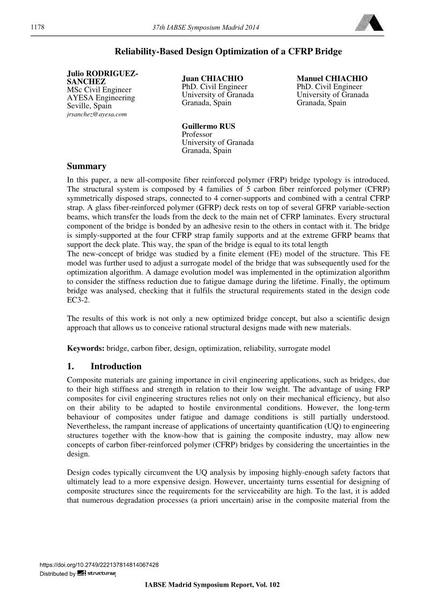Reliability-Based Design Optimization of a CFRP Bridge

|
|
|||||||||||
Bibliographic Details
| Author(s): |
Julio Rodriguez-Sanchez
Juan Chiachío Manuel Chiachío Guillermo Rus |
||||
|---|---|---|---|---|---|
| Medium: | conference paper | ||||
| Language(s): | English | ||||
| Conference: | IABSE Symposium: Engineering for Progress, Nature and People, Madrid, Spain, 3-5 September 2014 | ||||
| Published in: | IABSE Symposium Madrid 2014 | ||||
|
|||||
| Page(s): | 1178-1185 | ||||
| Total no. of pages: | 8 | ||||
| Year: | 2014 | ||||
| DOI: | 10.2749/222137814814067428 | ||||
| Abstract: |
Juan CHIACHIOPhD. Civil Engineer University of Granada Granada, Spain Guillermo RUSProfessor University of Granada Granada, Spain Manuel CHIACHIO PhD. Civil Engineer University of Granada Granada, SpainIn this paper, a new all-composite fiber reinforced polymer (FRP) bridge typology is introduced. The structural system is composed by 4 families of 5 carbon fiber reinforced polymer (CFRP) symmetrically disposed straps, connected to 4 corner-supports and combined with a central CFRP strap. A glass fiber-reinforced polymer (GFRP) deck rests on top of several GFRP variable-section beams, which transfer the loads from the deck to the main net of CFRP laminates. Every structural component of the bridge is bonded by an adhesive resin to the others in contact with it. The bridge is simply-supported at the four CFRP strap family supports and at the extreme GFRP beams that support the deck plate. This way, the span of the bridge is equal to its total length The new-concept of bridge was studied by a finite element (FE) model of the structure. This FE model was further used to adjust a surrogate model of the bridge that was subsequently used for the optimization algorithm. A damage evolution model was implemented in the optimization algorithm to consider the stiffness reduction due to fatigue damage during the lifetime. Finally, the optimum bridge was analysed, checking that it fulfils the structural requirements stated in the design code EC3-2. The results of this work is not only a new optimized bridge concept, but also a scientific design approach that allows us to conceive rational structural designs made with new materials. |
||||
| Keywords: |
design bridge reliability optimization surrogate model
|
||||
